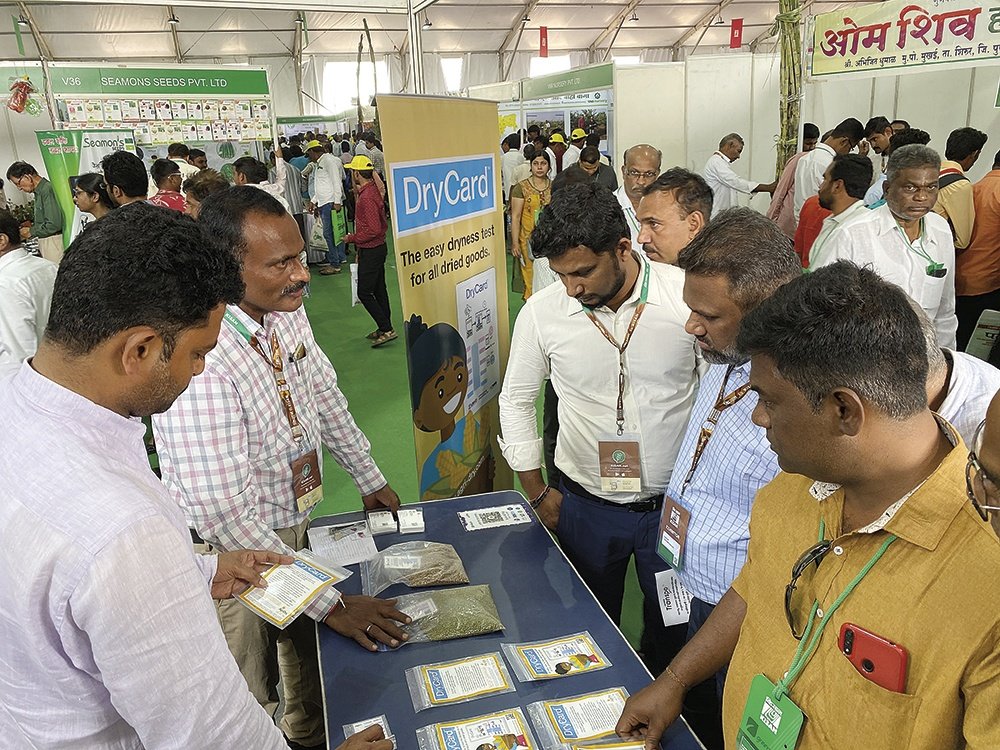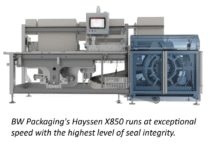
Groundnut (peanut; Arachis hypogaea L) is an important oilseed and food legume crop grown in India. Globally, India ranks first in groundnut cultivation area and second in the amount of groundnut production. India accounts for 31% of the total groundnut area in the world (24.6 million hectares) and 22 % of the total production (35.7 million tons).
Inadequate supply and availability of quality groundnut seed are the key constraints to higher productivity in India. Owing to the low seed multiplication ratio in groundnut, public sector agencies often fail to produce and supply enough quality seed of improved groundnut varieties.
The use of high-quality groundnut seeds helps in realizing not only the optimum yield potential of the improved cultivars but also enhances the adoption of accompanying improved, more sustainable production technologies and their synergistic effects. The low availability of quality seed of improved groundnut cultivars in the required quantities, at the right time, and affordable price are major production constraints. All these factors have limited the spread of improved groundnut cultivars in India. Furthermore, this leads to low varietal replacement and lagging adoption rates. Hence, consistent production of high quality groundnut remains a key issue in India.

Research and knowledge sharing: Dry Chain study for groundnuts in India
Vivia Foundation and its research partners began a pilot research study in Andhra Pradesh, India, to introduce and test Dry Chain methods for groundnuts. The study was a practical, on-farm pilot research program comparing traditional post-harvest methods with new Dry Chain methods.
Vivia Foundation and Renuka Bio Farms developed this “Dry Chain for Groundnut” research study with the University of California Davis, Mars Inc, and Grameena Vikas Samithi (GVS), a United Nations certified NGO in Andhra Pradesh. The study was implemented in cooperation with International Crop Research for the Semi-Arid Tropics (ICRISAT), the Telangana State Seed Certification Authority, and Vasudhaika Software Pvt Ltd who developed a mobile platform (Kalgudi) for field data collection, documentation and research analysis.
The study began with planting groundnut crops during the Kharif season in fall 2018 and continued through the Rabi Season harvest in Spring 2019. The study closely monitored farm practices for groundnut, consistent post-harvest drying of the groundnut, and crop storage conditions with relative humidity and aflatoxin monitoring for each farmers’ crop.
The research study incorporated a supervised farm-based introduction of Dry Chain practices and technologies. By working with local cooperating groundnut farmers to compare Traditional Agricultural Practices (TAP) with Good Agricultural Practices (GAP) during groundnut production, closely monitoring the storage conditions of groundnuts from both management systems using either traditional or Dry Chain methods.

Field research partners identified primary farmer collaborators during early 2018 and 2019. These farmers established groundnut crops on their farms, utilizing both GAP and TAP methods. On 1 November 2018, Dr Kent J Bradford of University of California, Davis, Rajan Reddy, Surya Reddy, Dr R Ratnakar – agriculture extensionist and Dr Keshavulu Kunusoth, director of Seed Certification in Telangana State met with a group of groundnut and mango farmers, including the primary cooperators, to discuss the objectives of the research study project and to solicit their input.
The study tracked the moisture, ambient temperature, Equilibrium Relative Humidity (ERH), and aflatoxin for each participating farmer over two planting seasons (wet and dry). Storage conditions were monitored over 90-days for both seasons.
The groundnut study included soil tests before planting and application of biofertilizers (rhizobium and phosphobacteria) as well as management advice from consultants during crop production.
The primary drying system was solar-based. Solar drying tarps were offered to the participating farmers and used in the field immediately after harvest to dry the groundnut. After crop harvest, the groundnuts were dried over a four to five-day solar tarp drying process at each farm site.

A greenhouse-style, clean-tech solar drying chamber structure was built with racks inside on which harvested products from each farmer’s field could be spread out in protected drying conditions to facilitate controlled, drying facilities. Large air fans inside of the 185 square meter drying chambers were engineered to increase consistent airflow over the product supplied by all participating farmers to rapidly dry the product before storage to reduce aflatoxins.
Half (50%) of the groundnuts from each of the production methods were stored in jute bags, and the other half (50%) were stored in moisture-proof hermetic crop storage bags. Small sensors were placed in each of the jute and hermetic storage bags to accurately monitor and collect real-time data for ERH and water activity, ambient temperature, dew point moisture, date, and time of day. DryCards™ were placed in each storage bag so that sensor data and calibrated water activity measurements of the groundnut product inside the storage bags could be compared to the DryCard’s special color paper strip indicator with a visual dryness scale, to determine the relative humidity level of the crop sample.
Vivia Foundation collaborated with Dr Hari Kishan Sudini and Dr P Janila at ICRISAT in Hyderabad, whereby ICRISAT agreed to conduct the aflatoxin assays for the project at continuous intervals.
Progress and findings to date
It was clear that the participating farmers became aware of the value of additional drying for preserving product quality by implementing Dry Chain processes. Farmers also realized the need to take such precautions in storing their seed stocks and dry food products for their subsequent planting, storage, or consumption. However, most farmers in India are paid by weight for every sack or bag and do not receive compensation for resulting weight loss (by reducing post-harvest humidity) or a bonus in the price for additional proper drying controls and higher quality.
The pilot study showed that for successful adoption of Dry Chain methods, changes in the trading and value chain system will be required in the future to reward farmers for taking these additional Dry Chain precautions to prevent aflatoxin accumulation –offering a premium for groundnut product delivered at a lower humidity level with a higher, food-safe quality.
The research also demonstrated the ease of use and accuracy of the DryCard™ system, while also underscoring the critical importance of maintaining post-harvest Dry Chain controls.

The study using the DryCard™ system and high-tech sensors demonstrated that there was a wide difference in the performance of various types of branded hermetic storage bags as compared to the jute (burlap) bags. While not as accurate as sensors, the study compared the visual indications of the easy-to-use DryCard™ strips to the precision sensor data to assess their ability to indicate safe versus unsafe product relative humidity (ERH) content levels.
The study demonstrated that there is a wide difference in the performance of various types of hermetic storage bags, especially under adverse very humid monsoon conditions, when aflatoxins became more prevalent over the 90-days storage period.
Under adverse, very humid monsoon conditions, the storage bags did not perform consistently, and aflatoxins became prevalent in several bags over the 90-days storage period. The Dry Chain project will, therefore, recommend well-tested polymer bags with multiple film layers, which can be reused and recycled or composted. Vivia Foundation is working to improve the design engineering for dry storage bags, combined with state-of-the-art processing, scanning and packaging technologies. The goal is to gain optimal, more reliable performance for agricultural food processing and storage with shelf-life extension.
Vivia Foundation and University of California Davis will be summarizing these findings and data analysis in a final research report to be completed in 2020. Vivia Foundation is committed to further the introduction of the Dry Chain to improve sustainable dry food and seed systems in India and its surrounding nations, specifically to SriLanka, Bangladesh, and United Arab Emirates.
Stakeholder engagement
The Dry Chain System will be implemented with full engagement of purposive stakeholders as well as consortium partners, both public sector and private sector. Events are planned to be able to reach agri-food practitioners and representative target groups to raise awareness about the Dry Chain project and to fine-tune implementation. Private seed companies, especially start-up companies and entrepreneurs who are interested in adopting the Dry Chain system for their production will be included as stakeholders. In addition to farmers, private enterprises and distributors are also invited to take part in the Dry Chain project execution as representatives and promoters.
Keeping in view of the importance of the Dry Chain and its potential impact on the value chains of many export crops, advisors in each targeted country will have the knowledge on the Dry Chain System. As advocates, they will become stakeholders in the Dry Chain project to increase food quality and reduce food waste. This will help to facilitate an effective transfer of the sustainable Dry Chain System and its benefits to farmers, traders, distributors, wholesalers, and food industry leaders targeted regions are India and South Asia’s Bangladesh, Sri Lanka and the United Arab Emirates.
Capacity strengthening & training
Necessary capacity building activities, including training programs, are being designed for a range of target groups including farmer cooperatives, Farmer-Producer Organizations (FPOs), Self Help Groups (SHGs), local distributors, agri-entrepreneurs, technical and packaging engineers and tribal communities. Training programs will be designed to be widely adopted by any group, community, company, or NGO.
An initial assessment recommends Dry Chain System implementation, technologies, post-harvest storage systems, as well as improved processing and packaging machinery. Training can extend to include on-farm operations for more sustainable systems that tie directly to Dry Chain methods. Men, women, and youth can be trained on the tools and technologies required for developing sustainable Dry Chain models. Capacity building programs are designed in such a way that they can be adopted easily at household, community, institutional, and commercial levels. For example, important Dry Chain storage interventions at the household level with the use of the low-cost DryCard™ safeguards that the food grains are kept for personal food-safe consumption. Nutritious food choices may become easier and more convenient when packaged in food-safe, conveniently sized sealed packages which are ready to cook or ready to eat.
Advantages for gender and youth enhancement
Women and youth play significant roles in production and processing across many developing countries, including India. Understanding the preferences of male and female farmers along the value chain is pivotal in developing appropriate technologies and tools. The current Dry Chain model will see a clear role for engagement of women and youth in Dry Chain Systems for improved seed multiplication as well as their improved post-harvest food distribution, farm cultivation, processing, and storage systems across target locations. The Dry Chain System will be established and promoted through capacity building of women (Self-Help Groups) and youth in the farm-centric villages. The existing (either village seed bank or farmer producer organizations) informal models will be customized and strengthened with necessary technical controls as well as industry linkages, augmented by interactive mobile communications, direct ordering of Dry Chain supplies, DryCard™ and farmer training.
The Dry Chain will help not only in improving the economies of scale of year-round food production and operations due to extended shelf-life during storage but also retaining improved, healthier food systems that extend from the farm gate to the home. This focus on gender and youth plays a significant role in creating greater access for improved crop cultivars and more productive crop yields.
Ultimately, Dry Chain practices will help the skills of women and youth in rural villages significantly by improving their household incomes and employment opportunities. Furthermore, the roles of women and youth will be explored in value-chains by linking them to various industrial and commercial facilities and markets in the locations where the Dry Chain System is used. Mobile platforms will be used to verify value chain activities and to promote market efficiencies through the Dry Chain model. When higher quality product can be verified and maintained through the Dry Chain System, incomes will increase, and livelihoods will improve. This approach for the Dry Chain aligns with Consultative Group for International Agricultural Research (CGIAR) gender platform as well as gender in seed systems goals.
Communication, accessibility, and outreach
Communication materials on the Dry Chain project will continue to be developed and shared through social media and agriculture industry networks. Policy briefs, project reports, videos, audio, mobile tools, and more are planned for posting on social networks, news releases, and local media.
A community platform for farmers, FPO’s and Self-Help Groups developed by Vasudhaika Software Pvt Ltd have already been created. Its Kalgudi platform currently serves 3.2 million farmers in India and surrounding countries. The Kalgudi platform will be utilized to help promote awareness of the Dry Chain System, to educate farmers (men, women, and youth) about the benefits of using the Dry Chain. Soon, the platform and its mobile connectivity will be able to deliver demonstration videos by user request, showing how to use the Dry Chain System for a wide variety of crop types, with information delivered in all major local languages. Farmers will be able to be notified of key actions specific to their crop to result in a successful Dry Chain process.
To start, orders for DryCard™ are made through online purchases for direct delivery of the cards with protective sleeves along with a DryCard™ Kit and other supplies. Each purchase of a DryCard™ Kit will include a donation for outreach, education, and skills training for expanding the knowledge and practice of the Dry Chain System and methods.
Relevance for development, policy, and practice
The Dry Chain System can be scaled-up easily in agricultural states of India and surrounding countries. The successful Dry Chain System for seed stock and cultivars, diverse dry foods, and horticulture products prevails under different agro-ecological situations and extreme climate conditions. Dry Chain should be promoted further with policy advocacy and support to hasten-up the adoption of these improved, affordable technologies.
The Dry Chain System demonstrates the use and application for various crops. It will significantly help the stakeholders and academic researchers to sensitize the policy makers in the respective target locations in India and South Asia, where the increasing effects of climate change is evident for staple crops. During monsoon seasons, post-harvest food waste is on the rise in these semi-arid tropical regions.
The women and youth will be capacitated through the many aspects of Dry Chain seed and crop production and increased market value of quality product. This will not only significantly improve their knowledge but also will enhance their household incomes and livelihood opportunities.
The field demonstration of the Dry Chain System and its on-farm cost-effective dry storage technologies will significantly improve the productivity every hectare of many crops in target locations. Ultimately, the growers in target locations will increase their incomes, household nutrition, and move out of poverty. Specifically, the more sustainable practices introduced by the project through the realization of the very simple and affordable Dry Chain System can be scaled-up easily through farmer’s training, on-farm demonstrations and direct communications.
Similarly, all the successful technologies introduced in the project can be quickly transferred and adopted in other countries where the dry lands crops and horticultural farming have a similar significant potential.
Conclusion
Our goal is to continue to enhance, adapt, simplify, and scale the integrated Dry Chain System so that it can easily and rapidly migrate throughout India and the surrounding countries, and beyond.
The Dry Chain System is developed and designed to build food security and resiliency for rural communities in developing nations and regions – especially those in the semi-arid tropics most affected by climate change.
Author bio: Cheryl E Harrison, chairman and program director of Vivia Foundation – Netherlands and develops innovative project initiatives worldwide.Vivia Foundation’s major focus is to conceive, integrate and implement programs guided by the sustainable development goals (SDGs) with resilient outcomes for complex value chains and social systems.
For Dry Chain research: (Bradford KJ, Dahal P, Van Asbrouck J, Kunusoth K, Bello P, Thompson J, Wu F (2018) The dry chain: Reducing postharvest losses and improving food safety in humid climates. Trends in Food Science & Technology 71: 84-93 https://doi.org/10.1016/j.tifs.2017.11.002
IndiFoodBev — authentic, impactful and influential
An English-language food and beverage processing and packaging industry B2B platform in print and web, IndiFoodBev is in its third year of publication. It is said that the Indian food and beverage industries represent approximately US$ 900 billion in revenues which implies more than 20% of the country’s GDP. Eliminating the wastage on the farmside can help to deliver more protein to a higher number of the population apart from generating sizable exports. The savings in soil, seeds, water, fertilizer, energy and ultimately food and nutrition could be the most immense contribution that country is poised to make to the moderation of climate change.
To improve your marketing and grow sales to the food and beverage processing and packaging industry, talk to us. Our research and consulting company IppStar [www.ippstar.org] can assess your potential and addressable markets in light of the competition. We can discuss marketing, communication, and sales strategies for market entry and growth.
Suppliers and service providers with a strategy and budget for targeted marketing can discuss using our hybrid print, web, video, and social media channels to create brand recognition linked to market relevance. Our technical writers are ready to meet you and your customers for content.
The second largest producer of fruit and vegetables in the world is continuously expanding processing capacities and delivery systems with appropriate innovative technologies. We cover product and consumer trends, nutrition, processing, research, equipment and packaging from farm to thali. Get our 2025 media kit and recalibrate your role in this dynamic market. Enhance your visibility and relevance to existing markets and turn potential customers into conversations. Ask for a sample copy of our bi-monthly in print or our weekly IndiFoodBev eZine each Wednesday.
For editorial info@ippgroup.in — for advertisement ads1@ippgroup.in and for subscriptions subscription@ippgroup.in
Naresh Khanna – 10 February 2025
Subscribe Now











